The Cambridge History of Japan, Vol. 3: Medieval Japan
Подождите немного. Документ загружается.

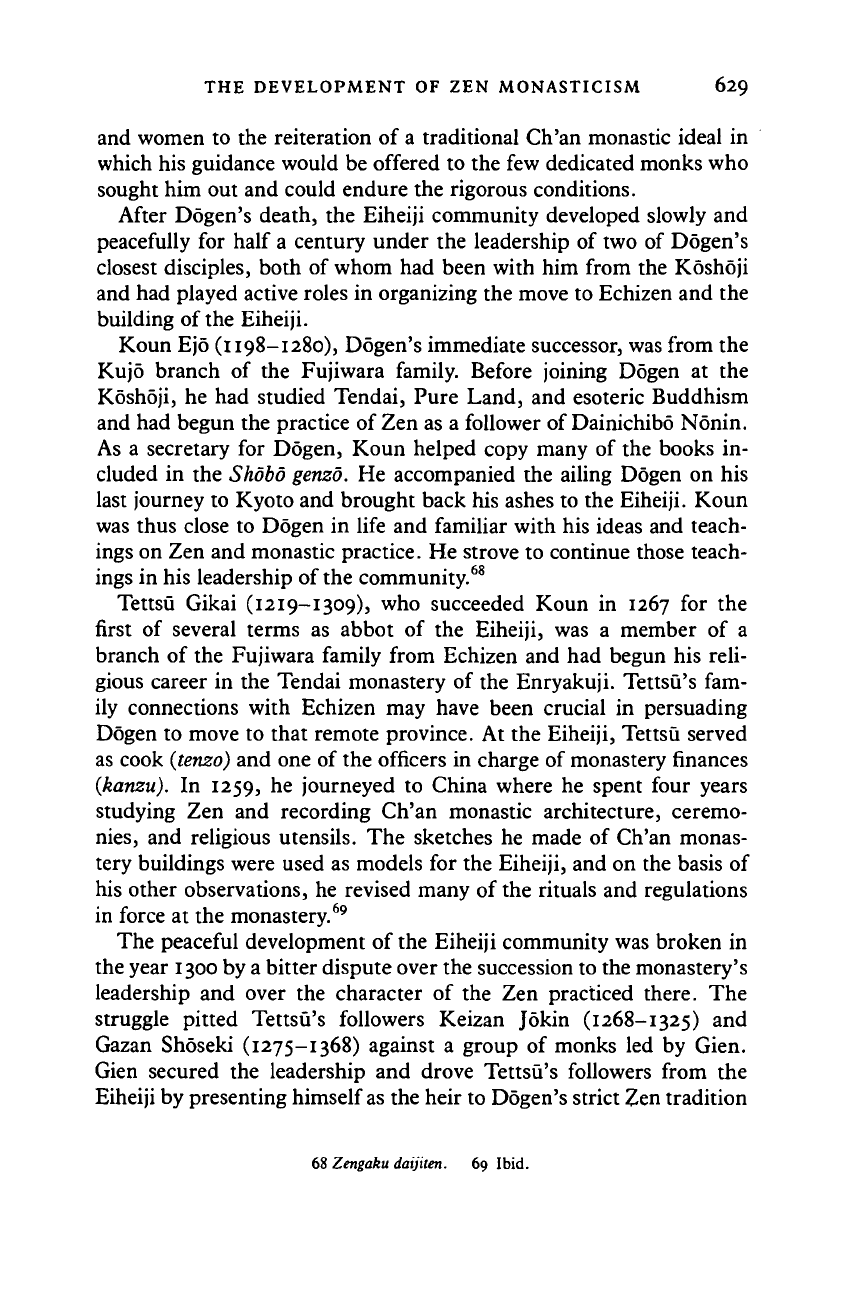
THE DEVELOPMENT OF ZEN MONASTICISM 629
and women to the reiteration of a traditional Ch'an monastic ideal in
which his guidance would be offered to the few dedicated monks who
sought him out and could endure the rigorous conditions.
After Dogen's death, the Eiheiji community developed slowly and
peacefully for half a century under the leadership of two of Dogen's
closest disciples, both of whom had been with him from the Koshoji
and had played active roles in organizing the move to Echizen and the
building of the Eiheiji.
Koun Ejo (1198-1280), Dogen's immediate successor, was from the
Kujo branch of the Fujiwara family. Before joining Dogen at the
Koshoji, he had studied Tendai, Pure Land, and esoteric Buddhism
and had begun the practice of Zen as a follower of Dainichibo Nonin.
As a secretary for Dogen, Koun helped copy many of the books in-
cluded in the Shobo
genzo.
He accompanied the ailing Dogen on his
last journey to Kyoto and brought back his ashes to the Eiheiji. Koun
was thus close to Dogen in life and familiar with his ideas and teach-
ings on Zen and monastic practice. He strove to continue those teach-
ings in his leadership of the community.
68
Tettsu Gikai (1219-1309), who succeeded Koun in 1267 for the
first of several terms as abbot of the Eiheiji, was a member of a
branch of the Fujiwara family from Echizen and had begun his reli-
gious career in the Tendai monastery of the Enryakuji. Tettsu's fam-
ily connections with Echizen may have been crucial in persuading
Dogen to move to that remote province. At the Eiheiji, Tettsu served
as cook
(tenzo)
and one of the officers in charge of monastery finances
(kanzu).
In 1259, he journeyed to China where he spent four years
studying Zen and recording Ch'an monastic architecture, ceremo-
nies,
and religious utensils. The sketches he made of Ch'an monas-
tery buildings were used as models for the Eiheiji, and on the basis of
his other observations, he revised many of the rituals and regulations
in force at the monastery.
69
The peaceful development of the Eiheiji community was broken in
the year 1300 by a bitter dispute over the succession to the monastery's
leadership and over the character of the Zen practiced there. The
struggle pitted Tettsu's followers Keizan Jokin (1268-1325) and
Gazan Shoseki (1275-1368) against a group of monks led by Gien.
Gien secured the leadership and drove Tettsu's followers from the
Eiheiji by presenting himself
as
the heir to Dogen's strict Zen tradition
68 Zengaku daijilen. 69 Ibid.
Cambridge Histories Online © Cambridge University Press, 2008

63O ZEN AND THE GOZAN
and attacking his rivals as advocates of the dilution and distortion of
that tradition.
70
There was some justice in Gien's charges: Both Keizan and Gazan
wanted to spread Soto Zen outside the Eiheiji cloister. They could
argue that efforts to proselytize were in keeping with the universalism
implicit in the Fukan
zazengi
and Bendowa, but they must also have
been aware that popularization could be attained only by relaxing the
strict, exclusive monastic practices enforced at the Eiheiji. Keizan
was,
by disposition, a syncretist. He had studied Tendai Buddhism
and had close ties with many of the monks and mountain ascetics
(yamabushi)
in the Tendai center at Hakusan. He had also studied
esoteric Buddhism and practiced Zen under Muhon Kakushin and
gozan
masters. After Keizan was excluded from the Eiheiji, he estab-
lished two new monasteries, the Sojiji and Yokoji, in Noto. The
former was converted from a Shingon temple, the latter from a Ritsu
(Vinaya) school center. Keizan's willingness to make accommodations
with other branches of Buddhism, to offer funeral and prayer services
for local warriors and farmers, and to hold mass meetings at which lay
people could do zazen or take the precepts all helped to set in motion a
rapid expansion of Soto Zen based on the Sojiji.
71
Keizan's work of popularization and diffusion was carried further
by Gazan, who attracted monks from all over Japan to study Zen
under his guidance at the Sojiji and Yokoji. Gazan is said to have had
twenty-five brilliant disciples. Among them, five monks - Daigen
Soshin (d. 1371), Tsugen Jakurei (1322-91), Mutan Sokan (d. 1387),
Daitetsu Sorei (1333-1408), and Jippo Ryoshu (d. 1405) - established
subtemples within the Sojiji. As in the case of the Rinzai monastery of
the Myoshinji, these subtemples provided abbots and supervision for
the Sojiji and became the nuclei for the diffusion of these branches of
Soto Zen throughout the provinces.
With the Daigen and Tsugen branches in the vanguard, Soto Zen
witnessed a dramatic, nationwide diffusion during the fifteenth and
sixteenth centuries. The details of that diffusion go beyond the scope
of this chapter. Some indication of its pace and extent, however, is
provided in the number of monasteries belonging to the Soto school.
At Gazan's death there were probably no more than 30 or 40 Soto
foundations. But a document dated 1745 refers to 16,554 Soto tem-
70
This "third-generation
dispute"
is
analyzed
by
Takeuchi
Michio,
"Nihon
ni
okeru Soto
Zen
no
tenkai,"
in
Koza
Zen, vol. 4
(Tokyo:
Chikuma
shobo,
1967),
pp. 152-5.
71 For a
more detailed account
of
this
expansion,
see
Takeuchi,
"Nihon
ni
okeru Soto
Zen no
tenkai."
Cambridge Histories Online © Cambridge University Press, 2008
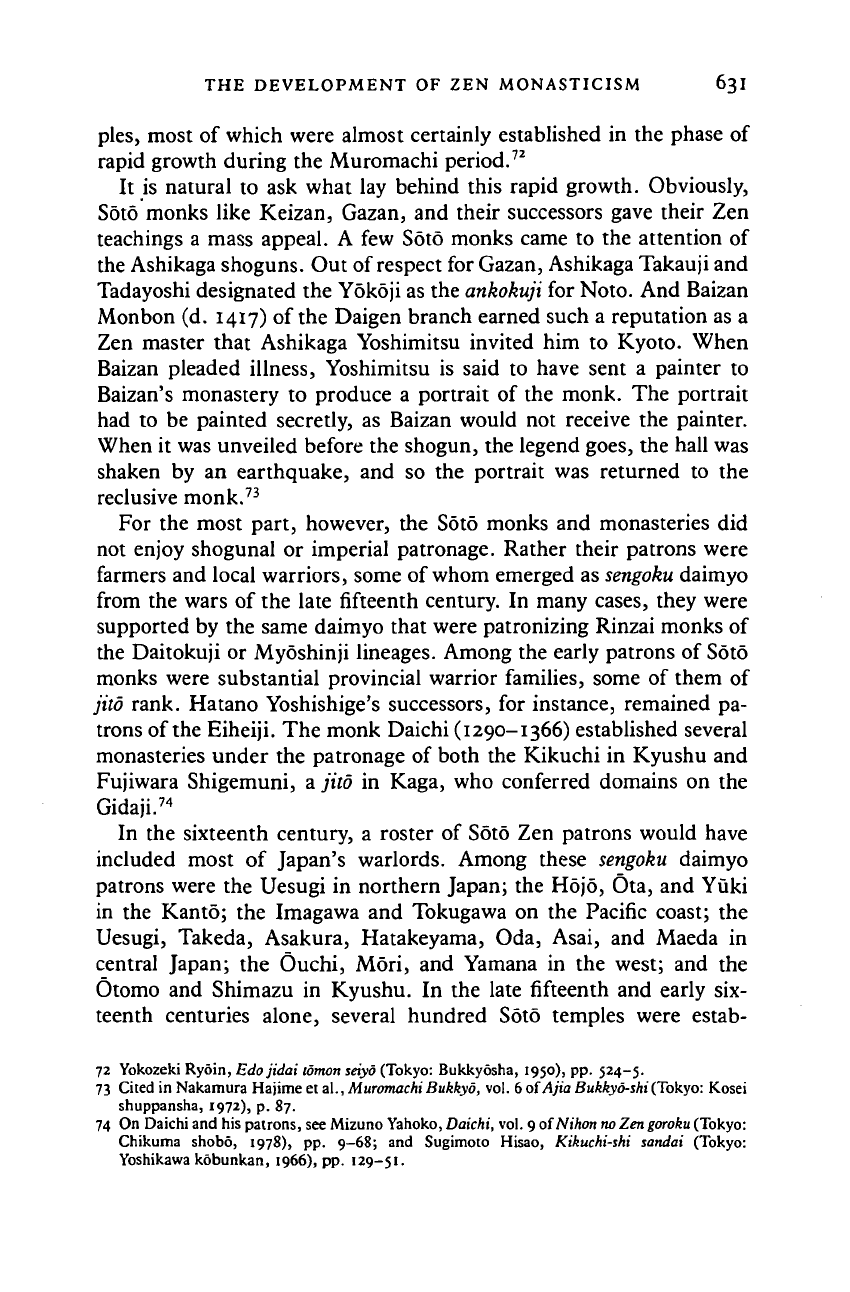
THE DEVELOPMENT OF ZEN MONASTICISM 63I
pies,
most of which were almost certainly established in the phase of
rapid growth during the Muromachi period.
72
It is natural to ask what lay behind this rapid growth. Obviously,
Soto monks like Keizan, Gazan, and their successors gave their Zen
teachings a mass appeal. A few Soto monks came to the attention of
the Ashikaga shoguns. Out of respect for Gazan, Ashikaga Takauji and
Tadayoshi designated the Yokoji as the ankokuji for Noto. And Baizan
Monbon (d. 1417) of the Daigen branch earned such a reputation as a
Zen master that Ashikaga Yoshimitsu invited him to Kyoto. When
Baizan pleaded illness, Yoshimitsu is said to have sent a painter to
Baizan's monastery to produce a portrait of the monk. The portrait
had to be painted secretly, as Baizan would not receive the painter.
When it was unveiled before the shogun, the legend goes, the hall was
shaken by an earthquake, and so the portrait was returned to the
reclusive monk.
73
For the most part, however, the Soto monks and monasteries did
not enjoy shogunal or imperial patronage. Rather their patrons were
farmers and local warriors, some of whom emerged as
sengoku
daimyo
from the wars of the late fifteenth century. In many cases, they were
supported by the same daimyo that were patronizing Rinzai monks of
the Daitokuji or Myoshinji lineages. Among the early patrons of Soto
monks were substantial provincial warrior families, some of them of
jito rank. Hatano Yoshishige's successors, for instance, remained pa-
trons of the Eiheiji. The monk Daichi (1290-1366) established several
monasteries under the patronage of both the Kikuchi in Kyushu and
Fujiwara Shigemuni, a jito in Kaga, who conferred domains on the
Gidaji.
74
In the sixteenth century, a roster of Soto Zen patrons would have
included most of Japan's warlords. Among these sengoku daimyo
patrons were the Uesugi in northern Japan; the Hojo, Ota, and Yuki
in the Kanto; the Imagawa and Tokugawa on the Pacific coast; the
Uesugi, Takeda, Asakura, Hatakeyama, Oda, Asai, and Maeda in
central Japan; the Ouchi, Mori, and Yamana in the west; and the
Otomo and Shimazu in Kyushu. In the late fifteenth and early six-
teenth centuries alone, several hundred Soto temples were estab-
72 Yokozeki Ryoin, Edojidai tomon
seiyo
(Tokyo: Bukkyosha, 1950), pp. 524-5.
73 Cited in Nakamura Hajime et al., Muromachi Bukkyo, vol. 6 of Ajia Bukkyo-shi
(Tokyo:
Kosei
shuppansha, 1972), p. 87.
74 On Daichi and his patrons, see Mizuno Yahoko, Daichi, vol. 9 ofNihon
no
Zen
goroku
(Tokyo:
Chikuma shobo, 1978), pp. 9-68; and Sugimoto Hisao, Kikuchi-shi sandai (Tokyo:
Yoshikawa kobunkan, 1966), pp.
129-51.
Cambridge Histories Online © Cambridge University Press, 2008
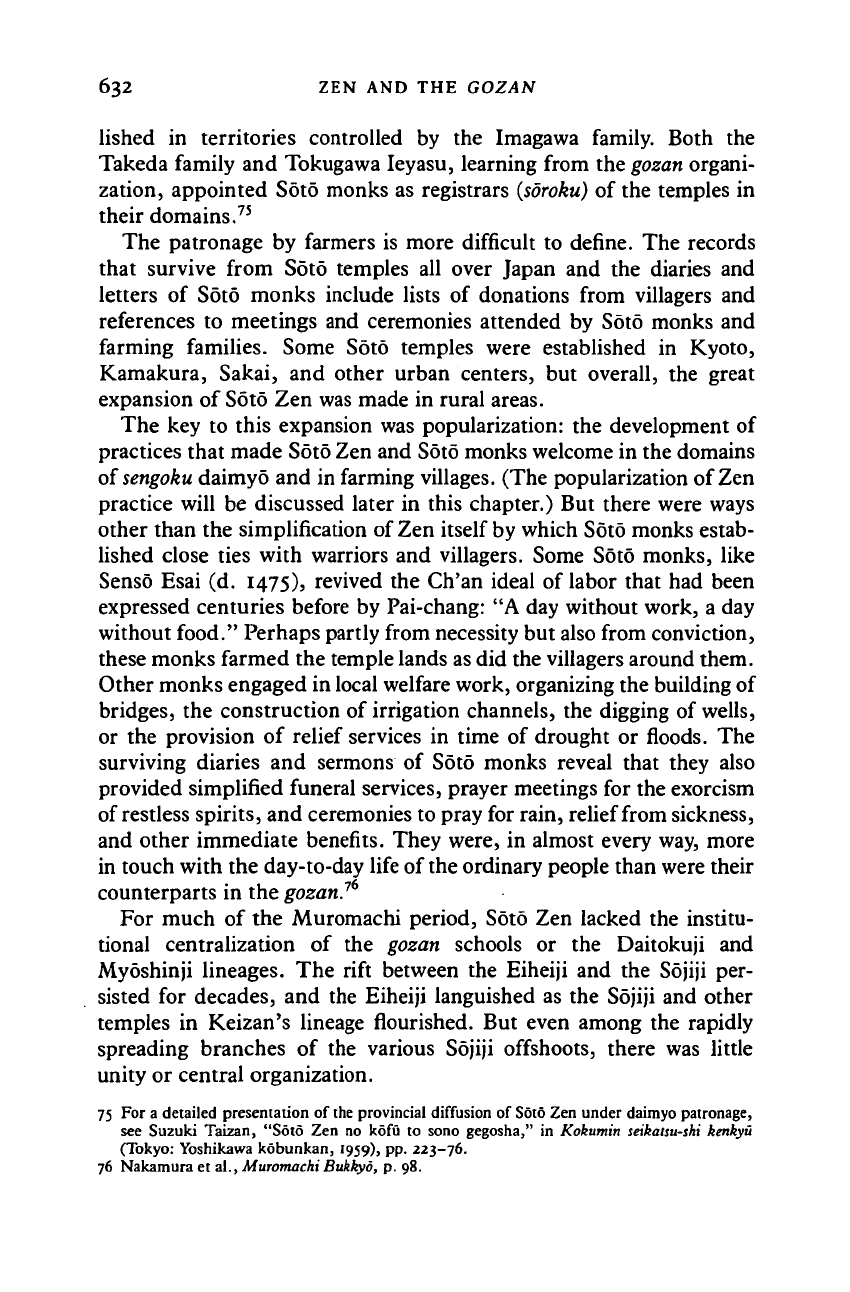
632 ZEN AND THE GOZAN
lished in territories controlled by the Imagawa family. Both the
Takeda family and Tokugawa Ieyasu, learning from the
gozan
organi-
zation, appointed Soto monks as registrars
(soroku)
of the temples in
their domains.
75
The patronage by farmers is more difficult to define. The records
that survive from Soto temples all over Japan and the diaries and
letters of Soto monks include lists of donations from villagers and
references to meetings and ceremonies attended by Soto monks and
farming families. Some Soto temples were established in Kyoto,
Kamakura, Sakai, and other urban centers, but overall, the great
expansion of Soto Zen was made in rural areas.
The key to this expansion was popularization: the development of
practices that made Soto Zen and Soto monks welcome in the domains
of
sengoku
daimyo and in farming villages. (The popularization of Zen
practice will be discussed later in this chapter.) But there were ways
other than the simplification of Zen itself by which Soto monks estab-
lished close ties with warriors and villagers. Some Soto monks, like
Sensd Esai (d. 1475), revived the Ch'an ideal of labor that had been
expressed centuries before by Pai-chang: "A day without work, a day
without food." Perhaps partly from necessity but also from conviction,
these monks farmed the temple lands as did the villagers around them.
Other monks engaged in local welfare work, organizing the building of
bridges, the construction of irrigation channels, the digging of wells,
or the provision of relief services in time of drought or floods. The
surviving diaries and sermons of Soto monks reveal that they also
provided simplified funeral services, prayer meetings for the exorcism
of restless spirits, and ceremonies to pray for rain, relief from sickness,
and other immediate benefits. They were, in almost every way, more
in touch with the day-to-day life of
the
ordinary people than were their
counterparts in the
gozan.
76
For much of the Muromachi period, Soto Zen lacked the institu-
tional centralization of the gozan schools or the Daitokuji and
Myoshinji lineages. The rift between the Eiheiji and the Sojiji per-
sisted for decades, and the Eiheiji languished as the Sojiji and other
temples in Keizan's lineage flourished. But even among the rapidly
spreading branches of the various Sojiji offshoots, there was little
unity or central organization.
75 For a detailed presentation of the provincial diffusion of Soto Zen under daimyo patronage,
see Suzuki Taizan, "Soto Zen no kofu to sono gegosha," in Kokumin seikatsu-shi kenkyu
(Tokyo: Yoshikawa kobunkan, 1959), pp. 223-76.
76 Nakamura et al., Muromachi Bukkyo, p. 98.
Cambridge Histories Online © Cambridge University Press, 2008
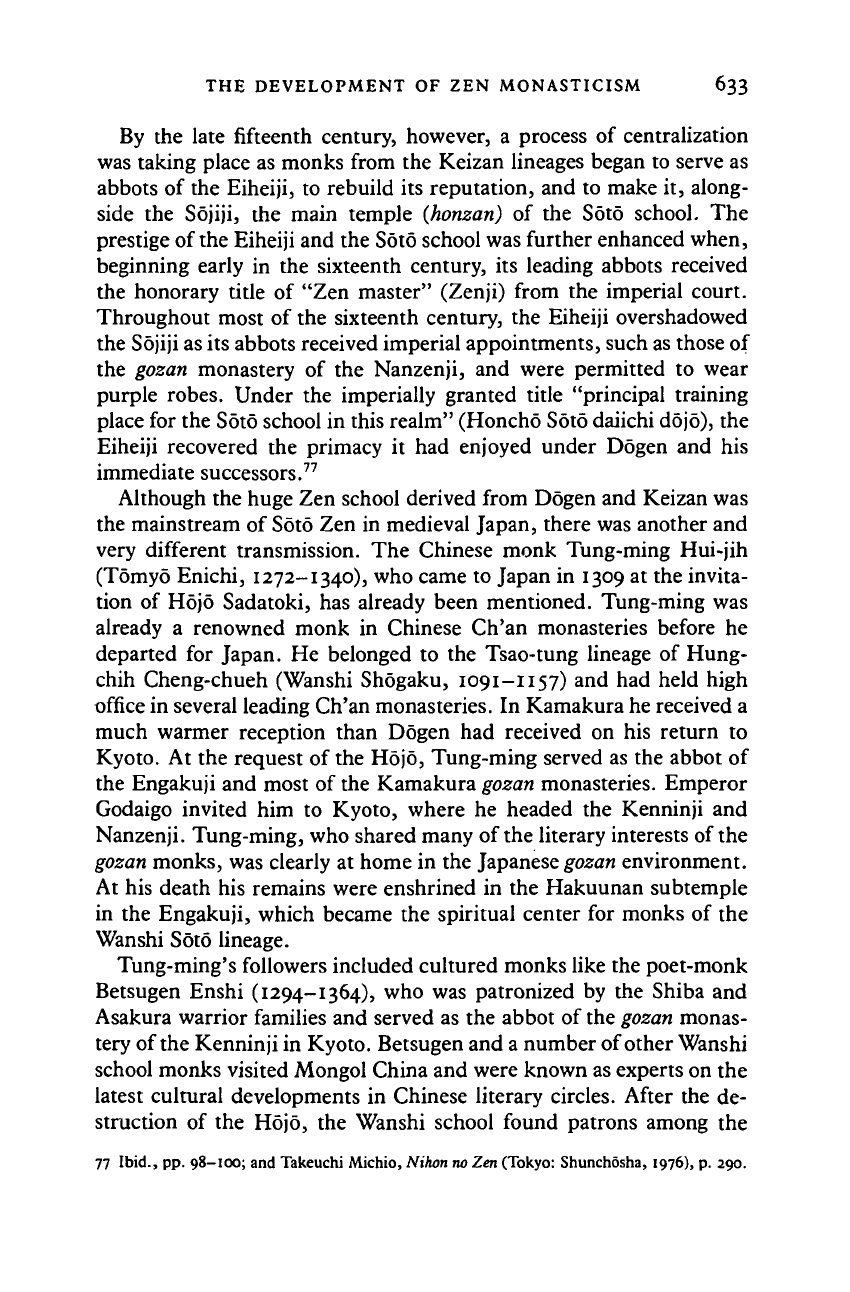
THE DEVELOPMENT OF ZEN MONASTICISM 633
By the late fifteenth century, however, a process of centralization
was taking place as monks from the Keizan lineages began to serve as
abbots of the Eiheiji, to rebuild its reputation, and to make it, along-
side the Sojiji, the main temple (honzan) of the Soto school. The
prestige of
the
Eiheiji and the Soto school was further enhanced when,
beginning early in the sixteenth century, its leading abbots received
the honorary title of "Zen master" (Zenji) from the imperial court.
Throughout most of the sixteenth century, the Eiheiji overshadowed
the Sojiji as its abbots received imperial appointments, such as those of
the gozan monastery of the Nanzenji, and were permitted to wear
purple robes. Under the imperially granted title "principal training
place for the Soto school in this realm" (Honcho Soto daiichi dojo), the
Eiheiji recovered the primacy it had enjoyed under Dogen and his
immediate successors.
77
Although the huge Zen school derived from Dogen and Keizan was
the mainstream of Soto Zen in medieval Japan, there was another and
very different transmission. The Chinese monk Tung-ming Hui-jih
(Tomyo Enichi, 1272-1340), who came to Japan in 1309 at the invita-
tion of Hojo Sadatoki, has already been mentioned. Tung-ming was
already a renowned monk in Chinese Ch'an monasteries before he
departed for Japan. He belonged to the Tsao-tung lineage of Hung-
chih Cheng-chueh (Wanshi Shogaku, 1091-1157) and had held high
office in several leading Ch'an monasteries. In Kamakura he received
a
much wanner reception than Dogen had received on his return to
Kyoto. At the request of the Hojo, Tung-ming served as the abbot of
the Engakuji and most of the Kamakura
gozan
monasteries. Emperor
Godaigo invited him to Kyoto, where he headed the Kenninji and
Nanzenji. Tung-ming, who shared many of the literary interests of the
gozan
monks, was clearly at home in the Japanese
gozan
environment.
At his death his remains were enshrined in the Hakuunan subtemple
in the Engakuji, which became the spiritual center for monks of the
Wanshi Soto lineage.
Tung-ming's followers included cultured monks like the poet-monk
Betsugen Enshi (1294-1364), who was patronized by the Shiba and
Asakura warrior families and served as the abbot of the
gozan
monas-
tery of the Kenninji in Kyoto. Betsugen and a number of other Wanshi
school monks visited Mongol China and were known as experts on the
latest cultural developments in Chinese literary circles. After the de-
struction of the Hojo, the Wanshi school found patrons among the
77 Ibid., pp. 98-100; and Takeuchi Michio, Nikon
no
Zen (Tokyo: Shunchosha, 1976), p. 290.
Cambridge Histories Online © Cambridge University Press, 2008
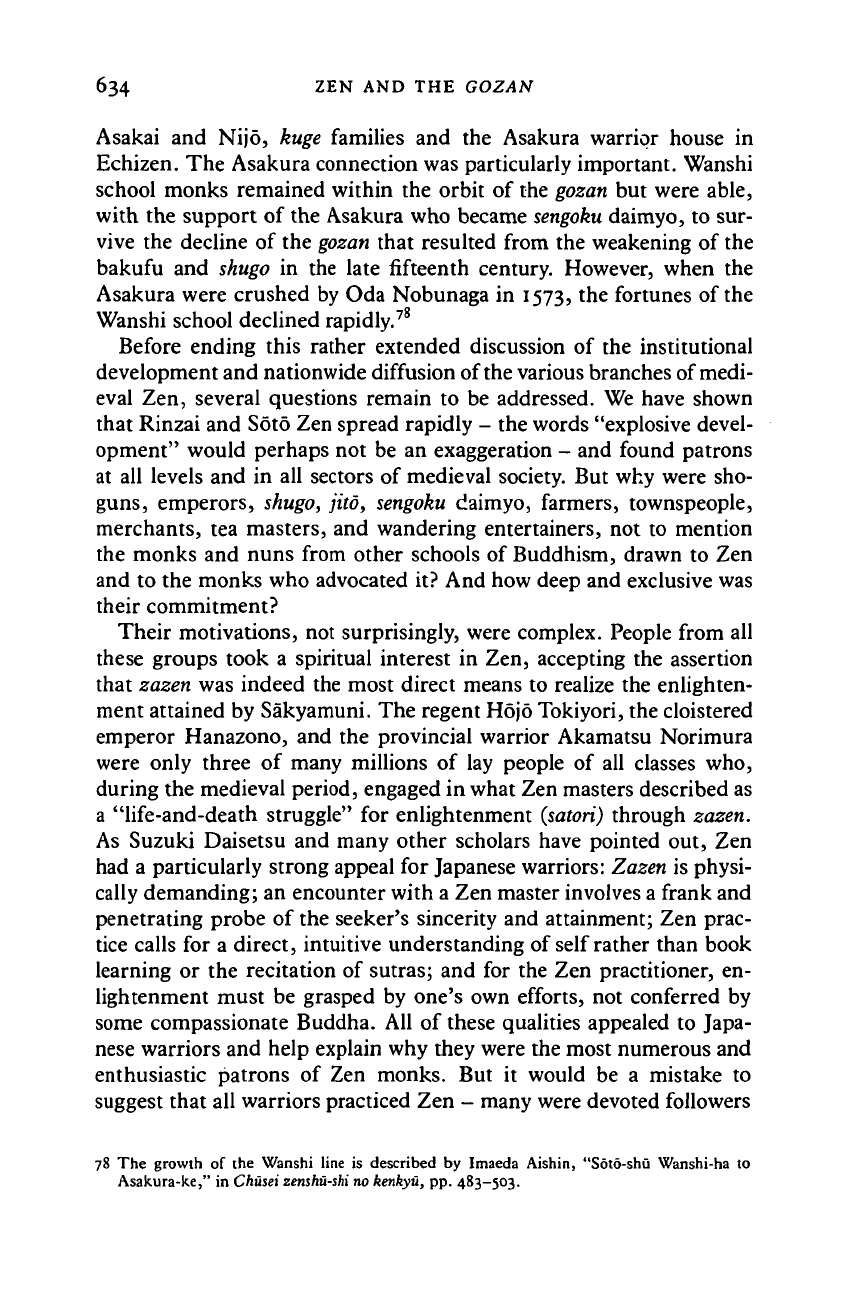
634
ZEN AND THE
GOZAN
Asakai and Nijo, kuge families and the Asakura warrior house in
Echizen. The Asakura connection was particularly important. Wanshi
school monks remained within the orbit of the
gozan
but were able,
with the support of the Asakura who became
sengoku
daimyo, to sur-
vive the decline of the
gozan
that resulted from the weakening of the
bakufu and shugo in the late fifteenth century. However, when the
Asakura were crushed by Oda Nobunaga in 1573, the fortunes of the
Wanshi school declined rapidly.
78
Before ending this rather extended discussion of the institutional
development and nationwide diffusion of the various branches of medi-
eval Zen, several questions remain to be addressed. We have shown
that Rinzai and Soto Zen spread rapidly - the words "explosive devel-
opment" would perhaps not be an exaggeration - and found patrons
at all levels and in all sectors of medieval society. But why were sho-
guns,
emperors,
shugo,
jito,
sengoku
daimyo, farmers, townspeople,
merchants, tea masters, and wandering entertainers, not to mention
the monks and nuns from other schools of Buddhism, drawn to Zen
and to the monks who advocated it? And how deep and exclusive was
their commitment?
Their motivations, not surprisingly, were complex. People from all
these groups took a spiritual interest in Zen, accepting the assertion
that zazen was indeed the most direct means to realize the enlighten-
ment attained by Sakyamuni. The regent Hojo Tokiyori, the cloistered
emperor Hanazono, and the provincial warrior Akamatsu Norimura
were only three of many millions of lay people of all classes who,
during the medieval period, engaged in what Zen masters described as
a "life-and-death struggle" for enlightenment
(satori)
through zazen.
As Suzuki Daisetsu and many other scholars have pointed out, Zen
had a particularly strong appeal for Japanese warriors: Zazen is physi-
cally demanding; an encounter with a Zen master involves a frank and
penetrating probe of the seeker's sincerity and attainment; Zen prac-
tice calls for a direct, intuitive understanding of self rather than book
learning or the recitation of sutras; and for the Zen practitioner, en-
lightenment must be grasped by one's own efforts, not conferred by
some compassionate Buddha. All of these qualities appealed to Japa-
nese warriors and help explain why they were the most numerous and
enthusiastic patrons of Zen monks. But it would be a mistake to
suggest that all warriors practiced Zen - many were devoted followers
78 The growth of the Wanshi line is described by Imaeda Aishin, "Soto-shu Wanshi-ha to
Asakura-ke," in Ckusei zenshu-shi no kenkyu, pp. 483-503.
Cambridge Histories Online © Cambridge University Press, 2008
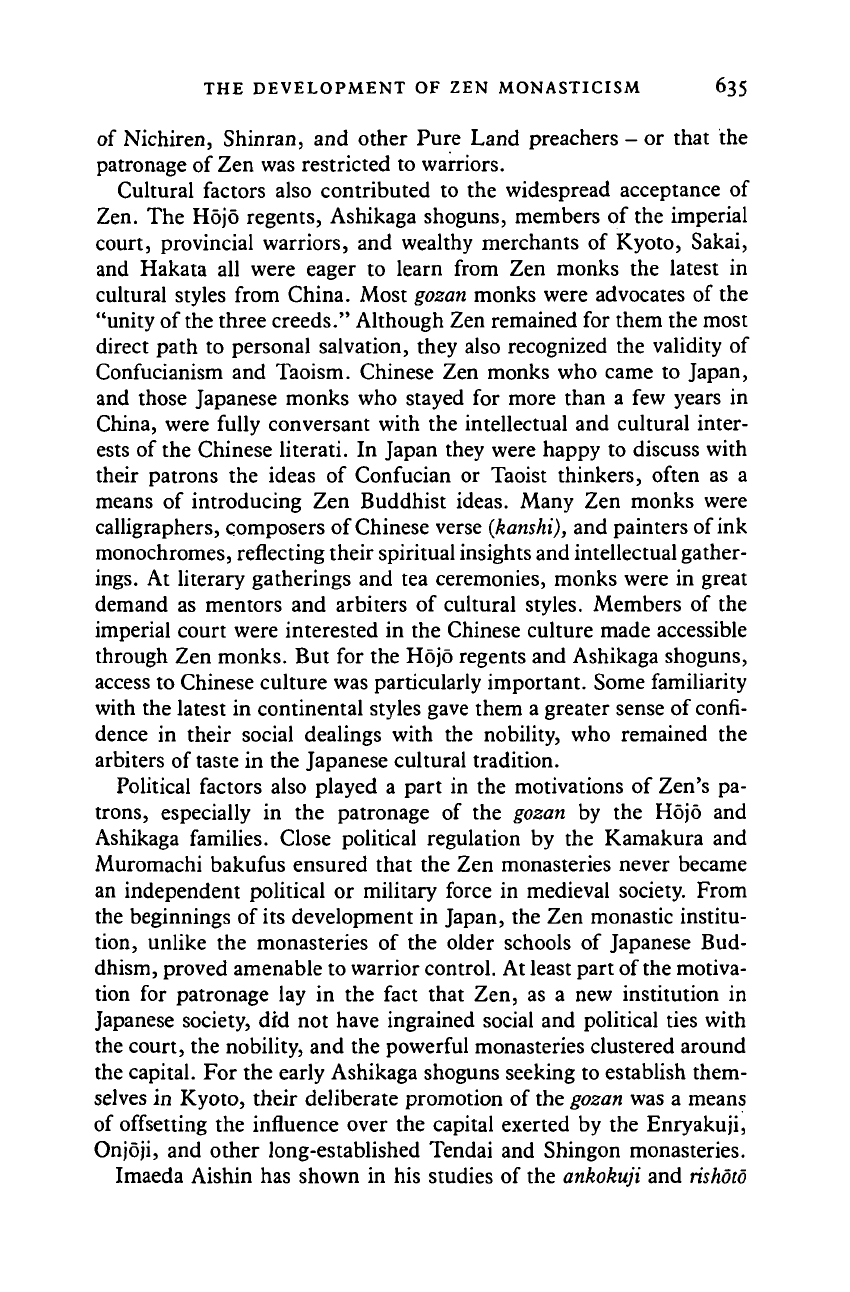
THE DEVELOPMENT OF ZEN MONASTICISM 635
of Nichiren, Shinran, and other Pure Land preachers - or that the
patronage of Zen was restricted to warriors.
Cultural factors also contributed to the widespread acceptance of
Zen. The Hojo regents, Ashikaga shoguns, members of the imperial
court, provincial warriors, and wealthy merchants of Kyoto, Sakai,
and Hakata all were eager to learn from Zen monks the latest in
cultural styles from China. Most gozan monks were advocates of the
"unity of the three creeds." Although Zen remained for them the most
direct path to personal salvation, they also recognized the validity of
Confucianism and Taoism. Chinese Zen monks who came to Japan,
and those Japanese monks who stayed for more than a few years in
China, were fully conversant with the intellectual and cultural inter-
ests of the Chinese literati. In Japan they were happy to discuss with
their patrons the ideas of Confucian or Taoist thinkers, often as a
means of introducing Zen Buddhist ideas. Many Zen monks were
calligraphers, composers of Chinese verse (kanshi), and painters of ink
monochromes, reflecting their spiritual insights and intellectual gather-
ings.
At literary gatherings and tea ceremonies, monks were in great
demand as mentors and arbiters of cultural styles. Members of the
imperial court were interested in the Chinese culture made accessible
through Zen monks. But for the Hojo regents and Ashikaga shoguns,
access to Chinese culture was particularly important. Some familiarity
with the latest in continental styles gave them a greater sense of confi-
dence in their social dealings with the nobility, who remained the
arbiters of taste in the Japanese cultural tradition.
Political factors also played a part in the motivations of Zen's pa-
trons,
especially in the patronage of the gozan by the Hojo and
Ashikaga families. Close political regulation by the Kamakura and
Muromachi bakufus ensured that the Zen monasteries never became
an independent political or military force in medieval society. From
the beginnings of its development in Japan, the Zen monastic institu-
tion, unlike the monasteries of the older schools of Japanese Bud-
dhism, proved amenable to warrior control. At least part of the motiva-
tion for patronage lay in the fact that Zen, as a new institution in
Japanese society, drd not have ingrained social and political ties with
the court, the nobility, and the powerful monasteries clustered around
the capital. For the early Ashikaga shoguns seeking to establish them-
selves in Kyoto, their deliberate promotion of the gozan was a means
of offsetting the influence over the capital exerted by the Enryakuji,
Onjoji, and other long-established Tendai and Shingon monasteries.
Imaeda Aishin has shown in his studies of the ankokuji and rishoto
Cambridge Histories Online © Cambridge University Press, 2008
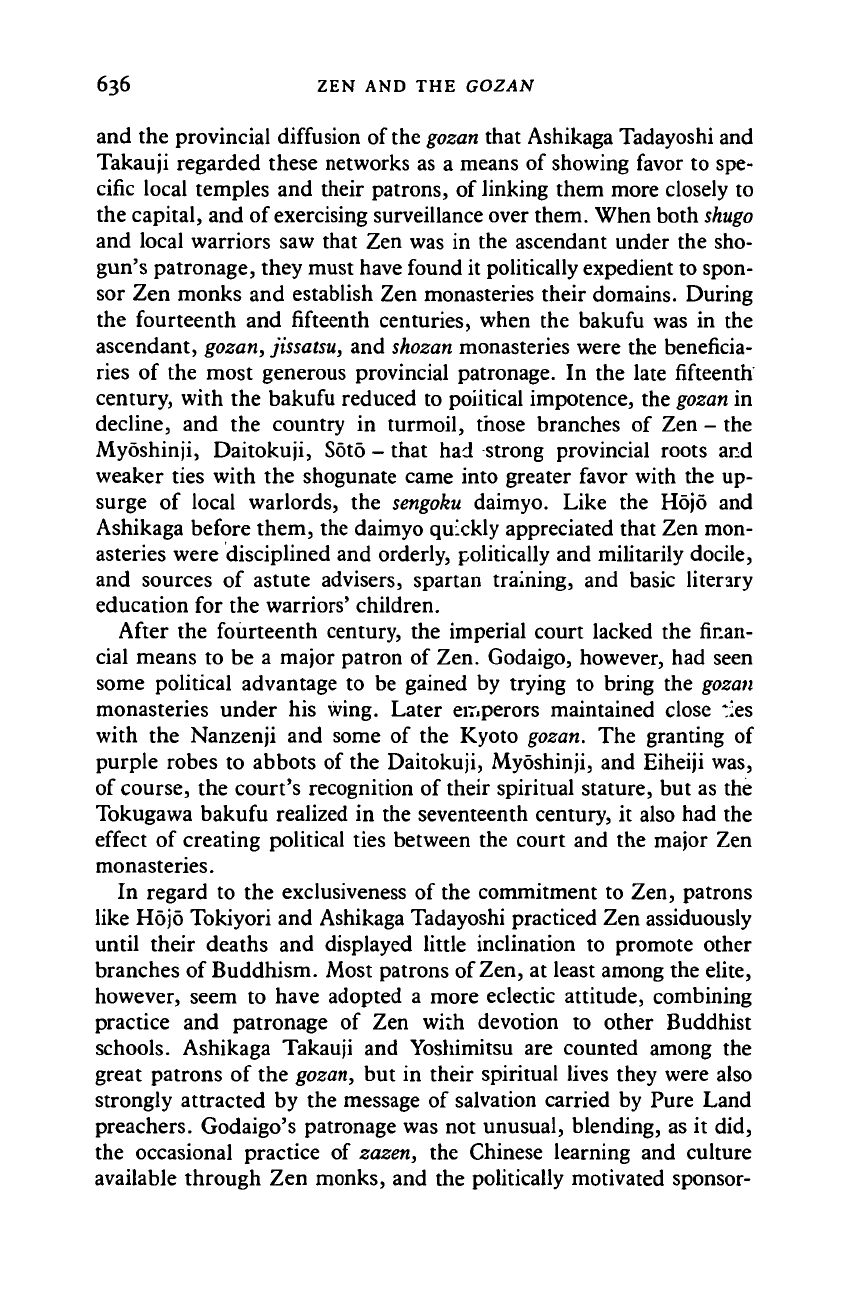
636 ZEN AND THE GOZAN
and the provincial diffusion of the
gozan
that Ashikaga Tadayoshi and
Takauji regarded these networks as a means of showing favor to spe-
cific local temples and their patrons, of linking them more closely to
the capital, and of exercising surveillance over them. When both
shugo
and local warriors saw that Zen was in the ascendant under the sho-
gun's patronage, they must have found it politically expedient to spon-
sor Zen monks and establish Zen monasteries their domains. During
the fourteenth and fifteenth centuries, when the bakufu was in the
ascendant,
gozan,
jissatsu,
and
shozan
monasteries were the beneficia-
ries of the most generous provincial patronage. In the late fifteenth
century, with the bakufu reduced to political impotence, the
gozan
in
decline, and the country in turmoil, those branches of Zen - the
Myoshinji, Daitokuji, Soto - that had strong provincial roots and
weaker ties with the shogunate came into greater favor with the up-
surge of local warlords, the
sengoku
daimyo. Like the Hojo and
Ashikaga before them, the daimyo quickly appreciated that Zen mon-
asteries were disciplined and orderly, politically and militarily docile,
and sources of astute advisers, spartan training, and basic literary
education for the warriors' children.
After the fourteenth century, the imperial court lacked the finan-
cial means to be a major patron of Zen. Godaigo, however, had seen
some political advantage to be gained by trying to bring the gozan
monasteries under his wing. Later emperors maintained close :;es
with the Nanzenji and some of the Kyoto gozan. The granting of
purple robes to abbots of the Daitokuji, Myoshinji, and Eiheiji was,
of course, the court's recognition of their spiritual stature, but as the
Tokugawa bakufu realized in the seventeenth century, it also had the
effect of creating political ties between the court and the major Zen
monasteries.
In regard to the exclusiveness of the commitment to Zen, patrons
like Hojo Tokiyori and Ashikaga Tadayoshi practiced Zen assiduously
until their deaths and displayed little inclination to promote other
branches of Buddhism. Most patrons of
Zen,
at least among the elite,
however, seem to have adopted a more eclectic attitude, combining
practice and patronage of Zen with devotion to other Buddhist
schools. Ashikaga Takauji and Yoshimitsu are counted among the
great patrons of the
gozan,
but in their spiritual lives they were also
strongly attracted by the message of salvation carried by Pure Land
preachers. Godaigo's patronage was not unusual, blending, as it did,
the occasional practice of zazen, the Chinese learning and culture
available through Zen monks, and the politically motivated sponsor-
Cambridge Histories Online © Cambridge University Press, 2008
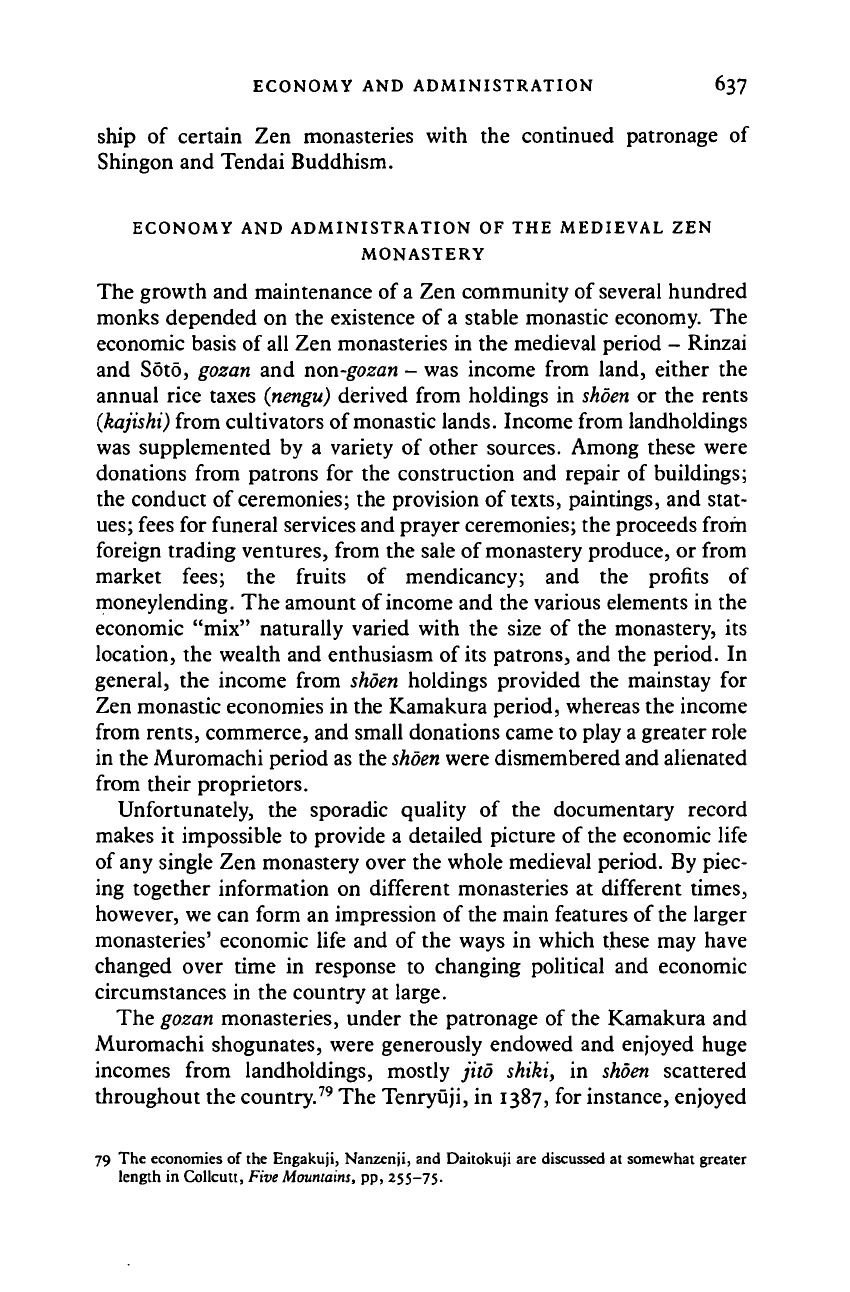
ECONOMY AND ADMINISTRATION 637
ship of certain Zen monasteries with the continued patronage of
Shingon and Tendai Buddhism.
ECONOMY AND ADMINISTRATION OF THE MEDIEVAL ZEN
MONASTERY
The growth and maintenance of a Zen community of several hundred
monks depended on the existence of a stable monastic economy. The
economic basis of all Zen monasteries in the medieval period - Rinzai
and Sotd, gozan and non-^ozan - was income from land, either the
annual rice taxes (nengu) derived from holdings in shoen or the rents
(kajishi) from cultivators of monastic lands. Income from landholdings
was supplemented by a variety of other sources. Among these were
donations from patrons for the construction and repair of buildings;
the conduct of ceremonies; the provision of texts, paintings, and stat-
ues;
fees for funeral services and prayer ceremonies; the proceeds from
foreign trading ventures, from the sale of monastery produce, or from
market fees; the fruits of mendicancy; and the profits of
moneylending. The amount of income and the various elements in the
economic "mix" naturally varied with the size of the monastery, its
location, the wealth and enthusiasm of its patrons, and the period. In
general, the income from shoen holdings provided the mainstay for
Zen monastic economies in the Kamakura period, whereas the income
from rents, commerce, and small donations came to play a greater role
in the Muromachi period as the
shoen
were dismembered and alienated
from their proprietors.
Unfortunately, the sporadic quality of the documentary record
makes it impossible to provide a detailed picture of the economic life
of any single Zen monastery over the whole medieval period. By piec-
ing together information on different monasteries at different times,
however, we can form an impression of the main features of the larger
monasteries' economic life and of the ways in which these may have
changed over time in response to changing political and economic
circumstances in the country at large.
The gozan monasteries, under the patronage of the Kamakura and
Muromachi shogunates, were generously endowed and enjoyed huge
incomes from landholdings, mostly jito shiki, in shoen scattered
throughout the country.
79
The Tenryuji, in 1387, for instance, enjoyed
79 The economies of the Engakuji, Nanzenji, and Daitokuji are discussed at somewhat greater
length in Collcutt, Five
Mountains,
pp, 255-75.
Cambridge Histories Online © Cambridge University Press, 2008
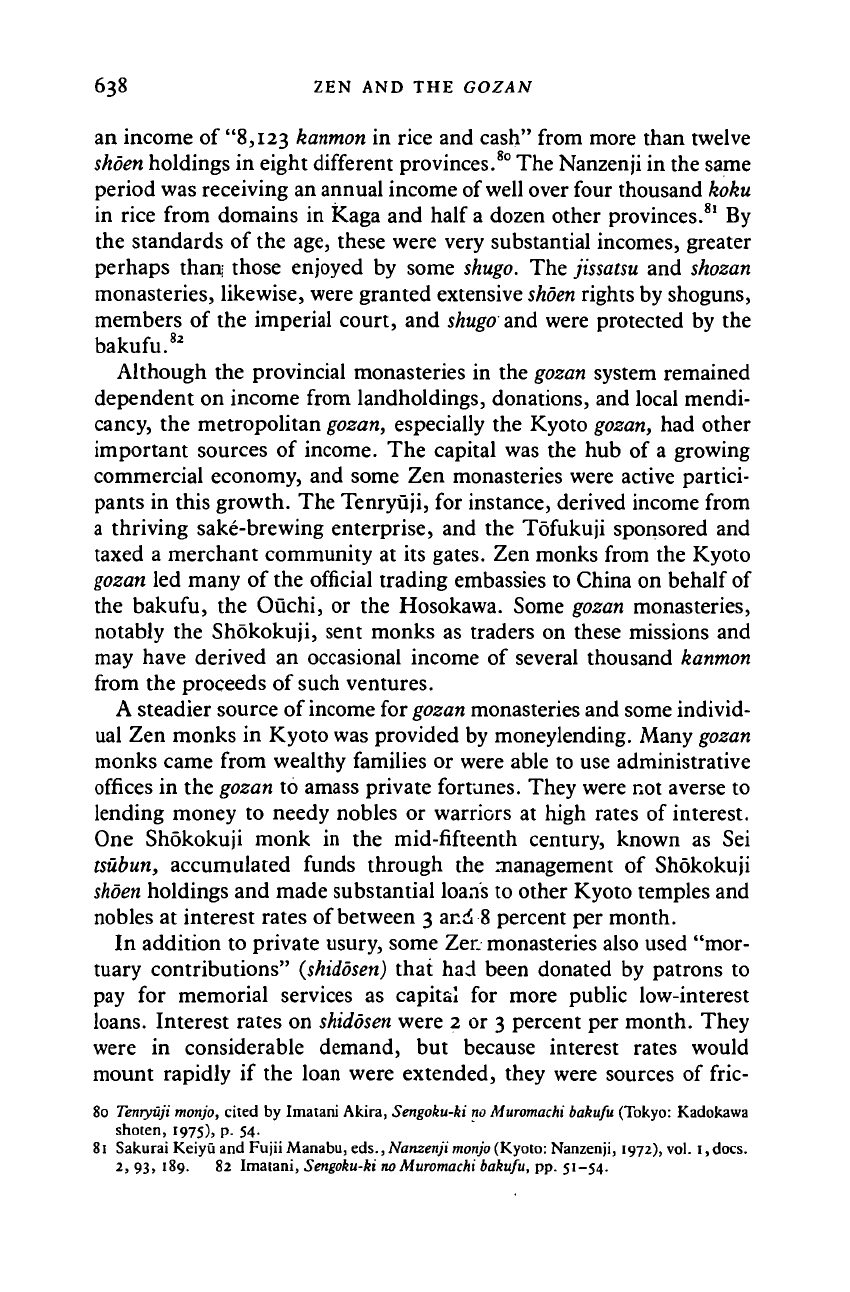
638 ZEN AND THE GOZAN
an income of "8,123
kanmon
in rice and cash" from more than twelve
shoen
holdings in eight different provinces.
80
The Nanzenji in the same
period was receiving an annual income of well over four thousand
koku
in rice from domains in Kaga and half a dozen other provinces.
81
By
the standards of the age, these were very substantial incomes, greater
perhaps than; those enjoyed by some
shugo.
The
jissatsu
and shozan
monasteries, likewise, were granted extensive
shoen
rights by shoguns,
members of the imperial court, and
shugo
and were protected by the
bakufu.
82
Although the provincial monasteries in the
gozan
system remained
dependent on income from landholdings, donations, and local mendi-
cancy, the metropolitan
gozan,
especially the Kyoto
gozan,
had other
important sources of income. The capital was the hub of a growing
commercial economy, and some Zen monasteries were active partici-
pants in this growth. The Tenryuji, for instance, derived income from
a thriving sake-brewing enterprise, and the Tofukuji sponsored and
taxed a merchant community at its gates. Zen monks from the Kyoto
gozan
led many of the official trading embassies to China on behalf
of
the bakufu, the Ouchi, or the Hosokawa. Some
gozan
monasteries,
notably the Shokokuji, sent monks as traders on these missions and
may have derived an occasional income of several thousand kanmon
from the proceeds of such ventures.
A steadier source of income for
gozan
monasteries and some individ-
ual Zen monks in Kyoto was provided by moneylending. Many
gozan
monks came from wealthy families or were able to use administrative
offices in the
gozan
to amass private fortunes. They were not averse to
lending money to needy nobles or warriors at high rates of interest.
One Shokokuji monk in the mid-fifteenth century, known as Sei
tsubun, accumulated funds through the management of Shokokuji
shoen
holdings and made substantial loans to other Kyoto temples and
nobles at interest rates of between 3 and 8 percent per month.
In addition to private usury, some Zer. monasteries also used "mor-
tuary contributions"
{shidosen)
that had been donated by patrons to
pay for memorial services as capital for more public low-interest
loans.
Interest rates on
shidosen
were 2 or 3 percent per month. They
were in considerable demand, but because interest rates would
mount rapidly if the loan were extended, they were sources of fric-
80 Tenryuji monjo, cited by Imatani Akira, Sengoku-ki no Muromachi bakufu (Tokyo: Kadokawa
shoten, 1975), p. 54.
81 Sakurai Keiyu and Fujii Manabu, eds., Nanzenji
monjo
(Kyoto: Nanzenji, 1972), vol. 1, docs.
2
> 93> 189. 82 Imatani, Sengoku-ki
no
Muromachi bakufu, pp. 51-54.
Cambridge Histories Online © Cambridge University Press, 2008
